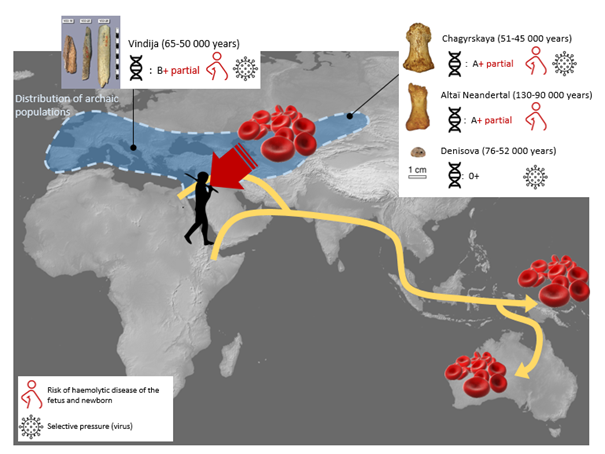Neanderthals and Denisovans are extinct hominin lineages but were present throughout Eurasia from 300,000 to 40,000 years ago. This paper isn't the first time they have been sequenced but using the genes underlying blood groups in previously sequenced genomes of one Denisovan and three Neanderthal females who lived 100,000 to 40,000 years ago allowed scholars to identify their blood groups.
Of the 40-some known blood group systems, the team concentrated on the seven usually considered for blood transfusion purposes, the most common of which are the ABO (determining the A, B, AB, and O blood types) and Rh systems.

Geographic origin, blood group and dating of individuals studied. Rh blood group system analysis (+ = full Rh(D) antigen ; + partial = partial Rh(D) antigen / - = missing Rh(D) antigen) suggested risk of haemolytic disease of the fetus and newborn among Neandertals and revealed interbreeding (possibly in the Levant), traces of which might be found in modern humans from Australia and Papua New Guinea. In three of the individuals, the presence of a ‘non-secretor’ allele, associated with protection from certain viruses, suggests selective pressure exerted by the latter. Credit: © Stéphane Mazières (photos: Douka et al. / Mafessoni et al. / Prüfer et al. / Green et al
The findings wouldn't add much, they didn't do original work, except it has been assumed that Neanderthals were all type O, the way chimpanzees are all type A and gorillas all type B but the new paper showed these ancient hominins already displayed the full range of ABO variability observed in modern humans. Extensive analysis covering other blood group systems turned up alleles that argue in favour of African origins for Neanderthals and Denisovans.
The three Neanderthals even harbored a unique Rh allele absent in modern humans—with the notable exceptions of one Aboriginal Australian and one Papuan. That opens up new speculation about interbreeding of Neanderthals and modern humans before the migration of the latter into Southeast Asia?
Regarding Neanderthal demographics, these hominins exhibited very little genetic diversity, and that they may have been susceptible to haemolytic disease of the fetus and newborn (erythroblastosis fetalis)—due to maternofetal Rh incompatibility—in cases where Neandertal mothers were carrying the children of Homo sapiens or Denisovan mates. These clues strengthen the hypothesis that low genetic diversity together with low reproductive success contributed to the disappearance of Neanderthals.




Comments